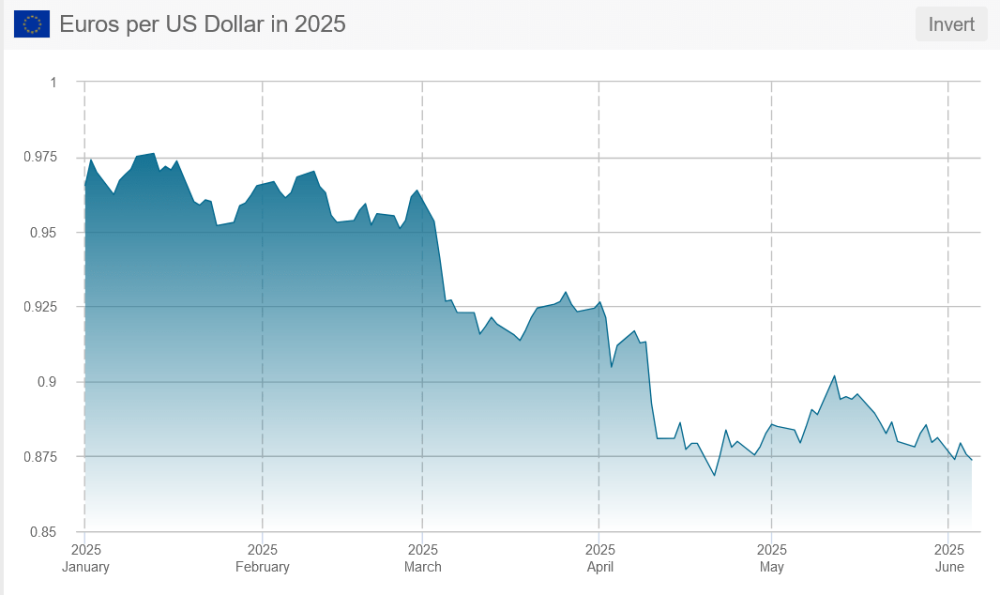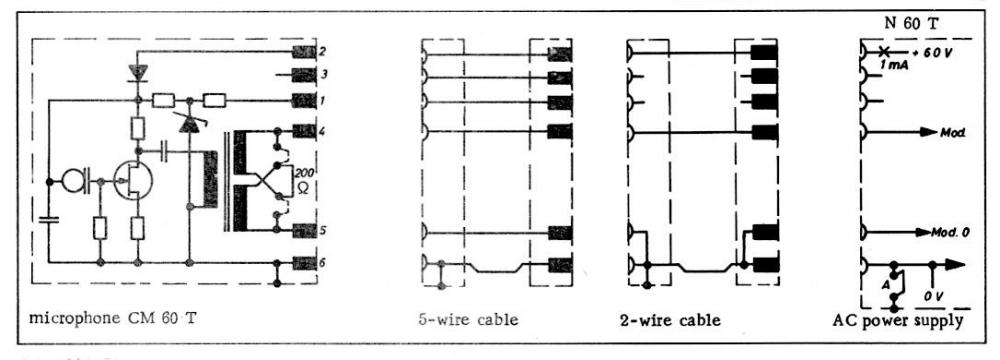
DSatz
Members-
Posts
33 -
Joined
-
Last visited
Profile Information
-
Location
New York
-
About
Classical musician/location recording engineer
-
Interested in Sound for Picture
Yes
Recent Profile Visitors
3,371 profile views
-
The last U.S. price list was issued March 5, 2024 when (according to www.exchange-rates.org) one Euro was worth $1.08581 US. Now it is worth $1.13878, which is nearly 5% higher. The attached graph of dollar vs. Euro values is from www.dollarfx.org .
-
Constantin, yes, the KMIT uses the same, identical capsule "innards" as the CMIT series, including the moisture resistance that was developed in recent years. The principal differences are [a] the modularity, [b] the surface finish (and it can be ordered in other finishes just like any other Schoeps capsule or amplifier) [c] the housing sleeve (made of somewhat heavier material, and 20 mm diameter rather than 21), and finally [d] active circuitry, which other Schoeps capsules don't have (other than the BLM 03 C). That last part has certain implications. The KMIT has a connector typical of an active accessory rather than of a pure capsule such as the MK 41, and draws a small amount of power through it from the amplifier. So you can't run a KMIT "remote" from the amplifier on a Colette extension cable/tube/gooseneck/table stand. But with a CMC 1 L amplifier, you can use any of the functionally parallel, Lemo-based extension devices--which have better RF rejection anyway, since their wiring is completely balanced. The older amplifiers (CMC 3/4/5) will certainly work with the KMIT. But the CMC 6 and (especially) CMC 1 have, again, much better RFI rejection--and years ago, the need for that improved rejection was brought to the company's attention by the film sound community first and foremost. That's why the CMC 6 was upgraded with the "RFI Shield", and why the CMC 1 was designed from the ground up with RFI immunity as a principal consideration. Some audiophiles say that they still prefer the CMC 5; they find its discrete circuitry reassuring (just as their predecessors in earlier generations preferred point-to-point wiring over printed circuit boards, and claimed to hear a difference). But from what I've heard at the company, the CMC 6 and CMC 1 are really thought of as categorically better, not just newer--because their RFI immunity makes them more reliable, in effect, under modern conditions of use. The CMC 1 also has ~4 dB better headroom when powered at 48 Volts; I may not need that for my classical music recording, but if you record sound effects you very well might care about it. --best regards
-
Constantin, the earlier Schoeps digital mike amp--introduced nearly twenty years ago--was the CMD 2. It, too, was an AES42 device, but it supported only mode 1, in which the microphone is self-clocking, which means that you can't sync your recording to a camera or house clock, or run multiple microphones, unless your recorder has sampling rate conversion built in. The CMD 42 is indeed a complete redesign--as it should be, since the components available for a project like this are worlds better than they were twenty or even ten years ago. --I need to disclose occasionally that I've done translating and editorial consulting for Schoeps for many years, and I'm subject to the human tendency toward bias. (Also equalization.)
-
Yes, but a FET impedance transformer stage is primarily a current amplifier; the voltage coming from the capsule is generally quite sufficient. Analog microphones have to drive loads as low as 600Ω sometimes; the IEC standard says 1 kΩ or greater, but some preamps don't maintain that at the frequency extremes--and you want to avoid a frequency-selective voltage divider effect, which necessitates almost a mini-power amplifier stage at the output of the mike. But there's no such requirement if you're going from the impedance transformer directly into a converter; you can generally eliminate a circuit stage or two, and optimize your (internal) operating levels and impedances for best dynamic range. Neumann used a ganged, gain-ranging converter arrangement, and with some components that have been developed more recently, the input noise of the converter can be less of a problem to begin with. In the end the equivalent noise level of the combination can be within a dB or so of the corresponding analog microphone. Neumann achieved that in their AES42 microphones as well (they are certainly no slouches). Schoeps had the CMD 42 under development well before Neumann / Sennheiser backed out. They felt that there is some range of customers who could be helped by this technology, and its development wasn't taking away too many resources from their other work, and was inherently interesting, so they continued. It was also affected by the pandemic and the owner's and managers' decision not to let people go even though new orders plummeted for a while (since then, the difference has been more than made up for). They haven't gambled the whole farm on this one project, in other words. They'll do fine with their existing analog product line, which they've also been developing further. If manufacturers of mixers, recorders, and outboard gear choose now to offer more support for AES42, there'll be more of an "ecosystem"; if not, not. But there's no way that those other manufacturers could make digital microphones of a quality that people would want to use, so Schoeps has done their part--a big part in principle and potentially, in practice--and now we'll see.
-
Before the topic changes completely, let me just chime in to agree with Constantin that AES42 is definitely more than just a passive interface for receiving digital audio signals. Unlike AES3 it has a control channel that runs from the interface to the microphone(s) (along the same set of wires, of course), and quite a few essential commands are predefined in the standard, such that all AES42-compatible microphones should implement them. Some other commands are "defined but optional." And there's also a range of command codes available for manufacturers to define for themselves however they want, so that unique features can be offered. What you can do in Mode 2 that you can't do in Mode 1: [a] record synchronously with any given timing signals, such as a master clock, without using sampling rate converters [b] run multiple microphones without sampling rate converters. In Mode 1 each mike is independently self-clocking, and no two are ever exactly alike.
-
Um, no, I meant https://www.youtube.com/watch?v=2st7KzoEHlo starting at 24:01. This came up last August on an amateur audio forum that I sometimes participate in ("Tapers Section"), where someone had watched this video but perhaps didn't understand the German being spoken, and thought that Wittek was recommending to set analog preamps to low gain levels such as 20 dB for best noise performance, which definitely isn't right. Here's what I posted back then: > [T]he topic from about 24:00 to about 30:00 in the recorded talk is dynamic range, which takes into account both the noise floor and the maximum SPL of the signal chain. He's very concerned to compare apples with apples: the digital microphone with the analog microphone PLUS the preamp that you have to use with it [whether standalone or built into a mixer or recorder]. > As he says (ca. 26:30), the CMD 42 isn't limited by having to pump out high voltages (more electrical power) at higher SPLs, so its maximum SPL is a few dB higher than that of the CMC 6. But when you bring an analog mike preamp into the picture (ca. 27:15), the clipping point of its output becomes a much more serious limiting factor when you get near the maximum SPL of the microphone. In the slide at the point that you mentioned, he's saying (around 28:20) that you would need to limit the gain on your preamp to about 15 - 20 dB in order to avoid this overload at the maximum SPL. > He's definitely not saying that this is an optimal setting--on the contrary! His whole point is that analog preamps typically have lower input noise than the microphone's output noise only when set to higher gain levels than that, such as 30 - 35 dB. (This was shown in earlier slides, ca. 25:15 - 26:00.) Thus there exists no one gain setting for a typical analog preamp that both accommodates the maximum SPL of the microphone without clipping, and simultaneously offers the lowest noise for the quietest sounds that the microphone can pick up. If you need to record both at the very highest and the very lowest SPLs without touching any gain settings in between, the digital microphone offers a definite advantage as compared with the analog microphone--given that typical analog mike preamps can't put out 10, 20, 30 or more Volts (not that you really would want such levels to occur in practice). > But then he goes on to say two things. (ca. 28:55) "With suitable operation of the preamp, I can obtain performance from the analog system that is exactly as good, or nearly as good, as that of the digital microphone. But I must operate it in a suitable way; I must really set exactly the gain level that suits my application exactly." Secondly, (ca. 29:50) combination analog mike preamps and A/D converters exist that use multiple analog gain stages and gain ranging--and he says that such equipment can produce results that are very nearly equivalent to digital microphones. --best regards
-
There are real-world situations in which a digital microphone can offer an audibly lower noise floor than a comparable analog microphone. For years I used to think that digital microphones were just a rearrangement/refactoring of the same set of components (capsule, preamp, a/d converter) as in a digital recording setup with analog mikes, and yes, that is true for the most part. But the hitch is analog mike preamps (whether outboard or part of a mixer or recorder) and their noise levels and headroom in relation to their gain settings. Mike preamps, contrary to what some people apparently assume, are nearly all at their quietest when set to the upper range of their gain settings. If the sounds that you're recording include very high SPLs (even for brief intervals), you can't leave the gain of the preamp (or analog recorder or mixer input) set very high, or you'll clip the analog electronics. As a result, you have to set the gain for the loudest sound that you expect to pick up, which raises the noise floor for the quieter parts of whatever you're recording, compared to what that noise floor would have been at higher gain settings. Sometimes this raises the preamp's noise floor above that of the microphone or the recording environment. And that's a compromise that you don't have to make with digital microphones. As a result, every now and then people with real, professional experience find to their astonishment that digital microphones are quieter or even (as some have said) much quieter in certain recording scenarios than the comparable analog microphones had been for them before. I used to think those people were tripping--but now I realize that they could very well be describing their experience accurately, though perhaps not understanding that no, the microphones themselves aren't any quieter; it's the benefit of working without the occasional limitations of analog preamps. The effect isn't extremely common, but I think it's 100% real when it occurs. Does that explanation help? There's a video in German that Helmut Wittek from Schoeps posted on YouTube that goes into this; I could provide a breakdown of it in English if anybody wants. --best regards
-
"Compact" shotgun microphones: not quite there yet?
DSatz replied to Fred Salles's topic in Equipment
Hello. The capsule in the Schoeps CMIT 5 and "MiniCMIT" is absolutely one and the same (including the backplate)--it's not two different capsules with the same outward dimensions. Capsule assemblies are generally made without knowing which microphone they will go into. The shorter microphone has a shorter amplifier with no switches or LEDs. The fixed low-cut filters of the two types are a bit different (CMIT 5 = 3-pole, 80 Hz while MiniCMIT = 4-pole, 70 Hz) but the sensitivity and gain are the same. On a careful, direct comparison with low-frequency-heavy program material, given suitably loud playback I imagine that a difference could be heard--but that's hardly a typical use case. Films and videos have reportedly been made in which the sound recordist switched between the two types of microphone with no one hearing any difference, while to my knowledge no contrary outcome has been reported so far. -
Glenn, your hypothetical situation seems to assume an entirely undithered a/d converter. In a properly dithered system none of your conclusions apply. Very low-level signals may be close to the noise floor, but they won't suffer any distortion due to the small number of bits that are actively flipping in any given time span. --best regards
-
Especially where there is cable-borne electrical noise from RF, consider a CMC 1 L amplifier + MK 41 capsule as an alternative to a CCM. The combination is only 1 mm longer and the built-in protection against RF entering the CMC 1 via the cable is significantly more advanced than that in the CCM (or even the CMC 6). The total price is actually a bit less, and if you need a different capsule some day, you can get it without paying twice for the electronics of the mike, plus you can interpose a low-cut filter such as the CUT 60 or other active accessories when needed. The CMC 1 also uses significantly less operating current than the CCM and on 48-Volt phantom, has 4 dB higher maximum SPL before reaching the point of distortion. I guess to some people the unitary construction of the CCM is conceptually simple, so they may assume that it's better shielded, but actually the reverse is true especially where RF is present on the signal cable.
-
Just wanted to mention that it is the absolutely identical capsule. The capsules are in fact made without knowing which model of microphone they will become part of. --And on that topic, the company has put a lot of work during the past two years into making the capsules of their shotgun mikes more resistant to the effects of high humidity. With no public announcement they introduced a new generation of capsules (same acoustic design/performance/sound/specs as before) and watched as complaints decreased. There's now an upgrade program in place if you want to have a new capsule installed in your CMIT 5 or MiniCMIT -- see the fourth item in the "Service FAQ" on https://schoeps.de/en/support-service/service.html (English) or https://schoeps.de/support-service/service.html (German). (That text is preliminary and may change somewhat by the end of this week, but the essentials are there.) They've also posted some advice on their Web site about how to avoid the problems in general, though it's fairly common-sensical and will be well known to many people here ( https://schoeps.de/en/knowledge/knowledge-base/schoeps-microphones-in-extreme-weather-conditions.html in English, https://schoeps.de/wissen/knowledge-base/schoeps-mikrofone-bei-extremen-wetterbedingungen.html in German). --best regards
-
Interior windscreens: Schoeps B5D vs Rycote Baseball vs Cinela Leonard?
DSatz replied to Jim Feeley's topic in Equipment
Hi. The B 5 D was invented for use on the singers' microphones at an outdoor concert of The Three Tenors. Schoeps' products that start with "B" ("Besprechungsschutz" in German) are "close talking guards" or "pop screens". They're designed for when moving air is expected to arrive mainly in front of the capsule; that's where they have most of their protective effect. The "D" stands for Decca, who were planning to record the concert for CD and DVD release, and came to Schoeps asking for improved protection with the least possible effect on the sound quality. The products that Schoeps designs as windscreens have "W" ("Windschutz") at the start of their names. They enclose a larger volume of air and/or they keep the moving air equidistant from all sides of the capsule. And as a result they have much better protection for the rear sound inlet of pressure gradient capsules. --best regards -
Very good. Glad you could get that done in a reliable way. --best regards
-
JonG, "correcting" the blue dot (now known as "+5 dB") setting involves nothing more than disconnecting one solder bridge on the circuit board and connecting another, adjacent one instead. The CMC 3--, 4-- and 5-- amplifiers all came with schematics showing where in the circuit these bridges were. --best regards
-
Maurice, no, it's not. The CM 060 a/k/a CM 60 T was a transistorized version of the CM 60 microphone series which had used an EF 94 vacuum tube. The transistorized version was designed to be compatible with the power supplies for the older, tube-equipped microphones. So it has supply requirements, and a pin arrangement, different from any other solid-state microphone that I know of. Of course, since it doesn't have a tube, the connections are simpler (e.g. it doesn't need a filament voltage). But its modulation leads are completely isolated from the +60 Volt supply that it does need--and that rules out the use of phantom power. Attached is the part of Schoeps' 1974 flyer that shows how this type of microphone can be connected to a power supply, especially the partial diagrams on the left and right. Please note that nearly all the microphones of this series were close-speech cardioids, with significantly reduced response below about 200 Hz and elevated response between 5K and 10K for clarity when used with a windscreen, as they often were. At the time, Schoeps engraved the cardioid symbol without any special indication of modified response for speech pickup. Since these microphones were most often sold to a company in Germany that assembled public address systems, that didn't create a problem until the microphones were then resold on the used equipment market. Unfortunately a lot of people have bought them (or their CM 640 tube predecessors) as "vintage" products of a highly-regarded manufacturer, but they don't have a "vintage" tone (not even the tube models) and were never intended or designed for studio recording. Also, the company no longer supports or repairs these microphones, nor do they have any capsules (such as a standard cardioid) remaining for sale. --best regards







